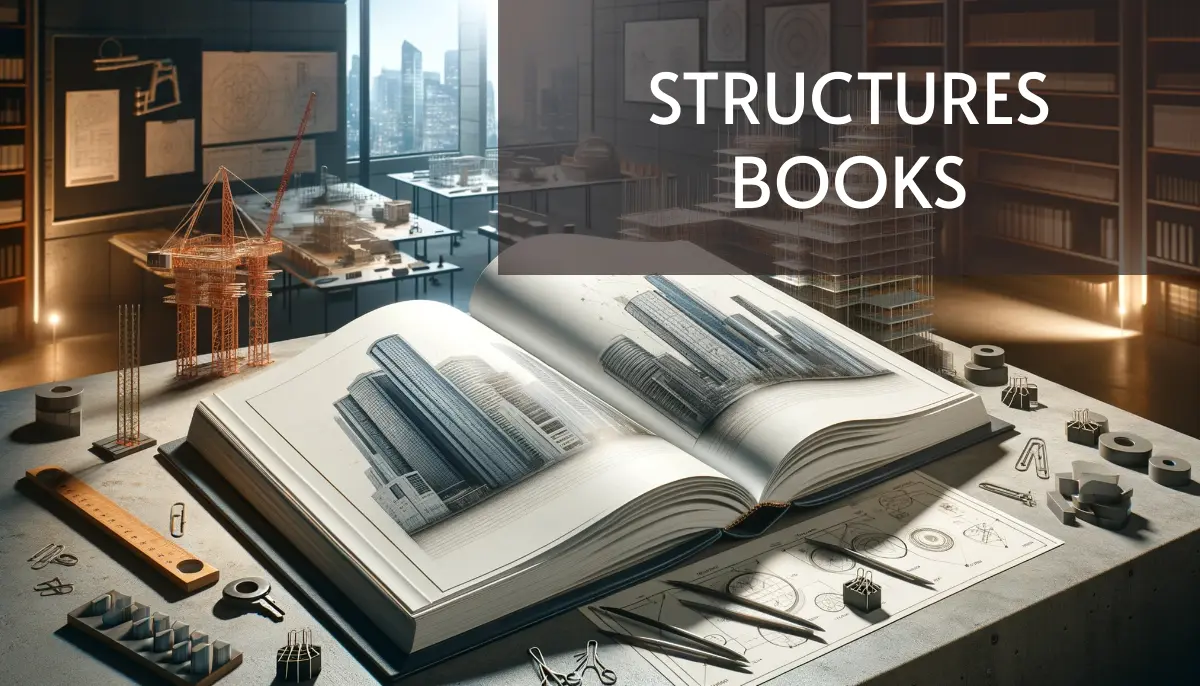It is thanks to structures that we can feel safe in the world we inhabit. Behind the construction of a building, for example, there is a whole science behind it that allows it to prevail over time, withstanding weight and climatic onslaughts. If your interest is in civil engineering or architecture, our collection of books on structures in PDF format will fit you like a glove.
Structures can be defined as extensions of a solid material that are created to support mechanical actions on it. Within this broad concept can be included those with discrete components such as a building structure, a metal bridge, a beam, or a shaft.
However, on this occasion, we will refer to the first type, as they are more closely related to civil engineering and architecture. There is a branch within both professions called structural engineering that, precisely, of the calculation and design of structures such as those of discrete components.
The structures that are responsible for this engineering to support their weight, plus the weight of loads exerted by the use, plus the loads related to environmental phenomena such as snow, wind, water, or earthquakes.
Check out this super collection of more than 45 materials including books and articles on structures in PDF format and learn all about their design by downloading the titles of your choice for free.
Structures books
Materials mechanics books
The field of mechanics of materials investigates how substances behave under external forces. Today we bring you books and articles on materials mechanics in PDF that will help you understand this topic more.
Materials mechanics also explores the underlying mechanisms that govern material behavior. Researchers analyze the atomic and molecular structure of substances, as well as the formation of defects and the interactions between different phases.
Overall, materials mechanics is crucial for advancing science and engineering. It helps researchers create materials with enhanced properties, from high-performance alloys to resilient structures.
Mechanics of materials and structures for construction managers
Kazimierz Józefiak, Magda Kruk,Fabian Linnebacher and others
Structural Analysis books
To learn more about structure analysis, we invite you to read books and articles on structure analysis in PDF where you can obtain a lot of interesting information.
The primary goal of structural analysis is to ensure the safety and reliability of structures. Engineers employ various techniques, such as finite element analysis and computer simulations, to predict the behavior of structures under different scenarios.
Overall, structural analysis is crucial in the field of engineering as it ensures that structures can bear their intended loads without failure. By considering factors like internal forces, stresses, and stability.
Structural design books
To learn more about structural design we invite you to read books and articles on structural design in PDF where you can get a lot of interesting information.
Structural design is the backbone of the built environment, providing stability and functionality to various structures. Engineers and architects work together to create designs that can withstand the forces of nature and fulfill the intended purpose of the construction.
With advancements in technology and materials, modern structural design has pushed the boundaries of what is possible. Innovations in computer modeling, simulation, and construction techniques have allowed for the creation of complex and visually stunning structures.
Construction materials books
Construction materials are the fundamental building blocks of any project, determining its strength, functionality, and aesthetic appeal. We leave you a compilation of books and articles on construction materials in PDF.
From traditional options like brick and stone to modern advancements like glass and composite materials, the choice of materials significantly impacts the outcome of a construction project.
The selection of construction materials is crucial in determining the success and longevity of a project. From the timeless beauty of wood to the strength of concrete and steel, each material brings its unique properties and advantages.
Earthquake resistant design books
Earthquake-resistant design is a critical aspect of construction in seismically active areas. To learn more about structure earthquake resistant design we invite you to read books and articles on earthquake-resistant design in PDF.
Advanced engineering techniques and innovative materials have revolutionized earthquake-resistant design, enabling buildings to withstand seismic forces and protect lives and property.
Earthquake-resistant design is a vital discipline that prioritizes the safety and durability of structures in seismic zones. Through the utilization of flexible materials, strategic load distribution, and attention to non-structural elements
Steel structures books
Steel structures have revolutionized the construction industry, providing immense strength and durability in a lightweight package. Read more about it on our compilation of books and articles on steel structures in PDF.
The exceptional properties of steel make it an ideal material for a wide range of structures, from residential buildings to industrial complexes. Its high tensile strength and resistance to bending and compression.
In conclusion, steel structures have transformed the construction landscape with their remarkable strength, efficiency, and adaptability. The speed of construction, versatility in design, and inherent durability of steel make it a favored choice for architects and engineers.
Concrete structure books
Concrete structures are essential in modern construction, offering strength, durability, and versatility. We leave you a compilation of books and articles on concrete structures in PDF.
The compressive strength of concrete allows for the construction of robust structures that can withstand heavy loads and adverse conditions.
Concrete structures are highly durable, resistant to fire and weathering, and require minimal maintenance, making them cost-effective and sustainable options in construction.
New Trends for Reinforced Concrete Structures - Some Results of Exploratory Studies
Ricardo N. F. Carmo and and Eduardo Júlio
Wooden structures books
Wooden structures are renowned for their natural beauty, versatility, and sustainability. Wood’s aesthetic appeal and warmth create a welcoming atmosphere in various architectural styles. We leave you a compilation of books and articles on wooden structures in PDF.
Sustainability is a key advantage of wooden structures. Wood is a renewable resource, and responsible harvesting practices ensure its long-term availability while reducing environmental impact.
Wooden structures offer excellent thermal insulation, contributing to energy efficiency and creating comfortable indoor environments. Wood’s natural insulating properties reduce the need for additional insulation materials.
Design of safe timber structures
Eva Frühwald, Erik Serrano,Tomi Toratti, Arne Emilsson and Sven Thelandersson
Tension Structures books
Tension structures have revolutionized the field of architecture, offering a unique and visually striking approach to design. Read more about it in our collection of books and articles on tension structures in PDF.
One of the key advantages of tension structures is their ability to span large distances with minimal material usage. By distributing loads through tensioned cables or membranes.
The flexibility of tension structures allows for endless design possibilities. They can be shaped into a variety of forms, including curves, domes, and canopies, offering architects and designers the freedom to create imaginative and iconic structures.
Tension Structures in ”Fifty years of progress for shell and spatial Structures”
René Motro
Here ends our selection of free Structures books in PDF format. We hope you liked it and already have your next book!
If you found this list useful, do not forget to share it on your social networks. Remember that “Sharing is Caring”.
Do you want more Engineering books in PDF format?
Engineering Books
| Aeronautical Engineering Books
| Agroindustrial Engineering Books
| Automotive Engineering Books
| Biochemical Engineering Books
| Biomedical Engineering Books
| Electrical Engineering Books
| Electromechanical Engineering Books
| Environmental Engineering Books
| Geological Engineering Books
| Geotechnical Engineering Books
| Industrial Engineering Books
| Mechanical Engineering Books
| Mechatronics Engineering Books







































